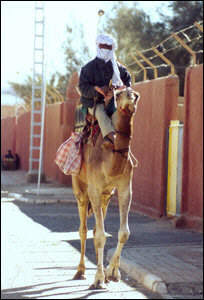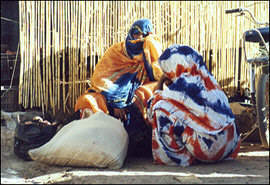 PEOPLE PEOPLE |
 Social Groups Social Groups |
The Algerian population is the result of a quite important regional variety, even if the majority of the population is from Berber and Arab origins. As a matter of fact, the official language is Arabic and is used by the State, education and Civil Service, but oral Algerian is divided up into about twenty accents througout Algeria. But Arabic is not the mother tongue of all Algerians, because Algeria is also the country of Tamazight, a Berber language which has been existing for more than 20 centuries. Tamazight became, only in 2002, a national and official language, as stipulated in the Algerian constitution.
In Kabylia (the wilayas of Tizi-Ouzou, Béjaïa, Bouira…), the spoken language is Kabilian, which derives from Tamazight. Kabylia, region known for claiming its identity since the independence, represents a different community in its social organisation, long based upon the Aarchs (important families in villages), while the m'rabet (Marabous) are a superior religious class, taken for granted and respected. Tamazight is spoken fluently by the Chawis (Batna, Khenchela, Souk Ahras, Tébessa), nevertheless, Chawi is clearly different from Kabylian. In that region, called the Aurès (because of the mountainous chain of the same name) people share with Kabilia a great devotion to the land, an agricultural vocation and some traditions, such as the burnous, a white cloak worn by men.

At the south of the country, in the M'zab region (Ghardaïa being the capital), the Mozabites speak another type of Tamazight, which distintive feature is to follow the ibadhite rite in Islam religion. This highly religious community is present throughout Algeria, and its members are very active in wholesale.
Further south, the Touaregs, from African origins, are a community which traditional territory goes beyond frontiers and spreads out on parts of Algeria, Nigeria and Mali. "The blue men", as we call them because of their blue clothing, are eternal nomads who travel along the numerous routes of Sahara and from a trading place to another. Their treatment, according to their specificity, is the result of an agreement between the three states. Their traditional political organisation is based upon a system of confederations, (Ahaggar, Ajjer, Tadamakat, Aïr, Ouadalan and Adagh). The colonial administration, then the new States gave them no political power. The Touarègue language, called Tamahaq, Tamajaq or Tamachaq, depending on the region, is one of the components of the Berber language. The Touaregs have an alphabet called Tifinagh, but the tradition has remained essentially oral. Their main economic activity is extensive breeding. A comprehensive study on this civilisation and its languages has been carried out by Le père Foucault, who shared their daily life for many years.
see table
Algeria has kept its traditions during centuries. The Algerians have always gathered to preserve their customs and traditions. That is how the Algerian folklore has stayed the same throughout generations: expression of natural feelings of spontaneous joy throughout dances, different depending on the region (Oranie, Saoura, Algérois, Kabylie, Constantine, Aurès, Sahara), accompanied by typical windward instruments: ghaïtas, mezoued, zamar, flute, guesba ; cord instruments: zbab, amzad ; or percussion instruments: darbouka, bendir, tbal, tbilet, tar, gallal. Their costumes are also very diversified.
Sahara is the most mysterious region; the populations of the South have kept to their traditions and customs their original and authentic character, particularly in the field of popular arts. The themes are often inspired from the inhabitants' life: marriages, child circumcision and water: the most precious element in the region. The baroud and other dances remind of the virility and the fierce character of warriors. Women, draped into shimmering colours, evolve around the dancers. A pure citizen art has been rooted in the most important cities of Algeria with a flourishing past: the Bennoutat of Constantine, Mesamâa of the capital. The saharan rhythms have got steps that can be found in several Afro-Cuban dances; in a dance of Laghouat there is the andalusian zapateado. Indeed, Algeria has been a vast digger of civilisations from where so many steams from the Orient to the Mediterranean and from the Mediterranean to Africa came and went .
 The Algerian woman The Algerian woman |
 | The problematic of the Algerian condition is certainly due to a change in the culture and the Arabization of a society that has known the Occident during numerous years. If Algeria can be characterised as being the most liberalised country in the Arabic world, it is not the case for the Algerian women, who do not share the same liberty as their Tunisian counterparts.
Women have actively participated to the war of liberation and the fight against terrorism imposed these last years. They also represent an important fringe of the new generation. Being conscious of this fact, they regularly set up demonstrations to claim for new rights. Measures have been proposed, for the last five years, to different governments to improve women condition in relation to the laws stipulated by " the family code", inspired by the chariaa (the Muslim religion) and recognised as being discriminatory towards women.
Several campaigns to raise the consciousness of the public opinion have been conducted to improve the women condition at several levels (social, economical…) and also led to the suppression of the vote by proxy which allowed the husband to vote instead of his wife. Algeria ratified in 1996 the international convention on the elimination of any type of sexual discrimination. In November 1999, the whole magistrature was modified, which guaranteed a significant participation of women in this field. Access to education and health has also been easier.
However, despite all the initiatives taken, some aspects remain unchanged. In fact, women do not have the same rights as men concerning the handing down of nationality to their children. The State does not recognise women's right to move along freely and to choose her place of residence. She has no right, either, to contract a marriage, to choose a husband by herself, to take decisions for her family, to run, manage or have the use of the family possessions as her husband can. There is no legislative text protecting women victims of domestic violence, including rape.
The Algerian woman plays a greater role in society. Women represented 17% on the labour market in 1998, with a strong concentration in the public sector. They represent 50% of the medical staff, 70 % of the teaching profession and industrial labour force. They have more responsibilities in companies, Civil Service, government and parliament. In the economical field, some associations have been created such as SEVE (contractors), which proves their dynamism.
Some figures:
- 5 Ministers of the government are women
- 19 women belong to the magistrature
- 11 out of 380 members of the parliament are women
- 25 % judges are women
- 72% girls end their cycle at middle school, the only compulsory cycle, compared to 86% boys because of scholar discrimination.
- Within the age bracket 15/24, 37,5% women are illiterate compared to 13,8% of boys.
- Only around 610 000 women are employed, which represents 13,2% of the activity of the country.
 Education Education |
Since 1962, schooling is free and compulsory for children aged from six to sixteen years old. It is called the "fundamental" cycle, nine year long (six years of primary school and three years of secondary school). Only 34% (in 2000) of the students who start the first year finish their fundamental cycle.
Algeria has got 8 universities (2 science and technology universities) attended by more than 200 000 students. At the university of Algeria, founded in 1879, it is possible to study several disciplines (law, medicine, sciences, arts and litterature). Nevertheless, higher education suffers from isolation from other universities of the rest of the world, the rate of graduated people does not exceed 10%, which is amongst the lowest of the world.
However, the Algerian education system did not succeed in answering the demands of the demographic explosion. Moreover, the sudden arabization of education introduced in 1972 led to the hastened training of French-speaking teachers. The government also needed foreign Arabic-speaking teachers.
The illiteracy rate decreased from 74,6% in 1966 to 37% in 2001, 46% for women and 27% for men. However, the difference between the rural and the urban zones, and the regions and sexes remains too heavy.
 The Algerian celebrities The Algerian celebrities |
Lakhdar Brahimi: Famous diplomat, he led, under UN mandate, the laborious discussions of Bonn, in December 2001, between the different Afghan movements, after the fall the Taliban regime. Many heads of State have paid tribute to his efforts to gain peace.
Mohamed Bedjaoui: Several times president of The Hague international court. Great lawyer and leading expert of international law, he was present at the working out of all the Constitutions of Algeria, from 1963 to 1996.
Nourredine Morcelli: Former 1500 m.world champion and olympic champion in the 1990's, this athlete still holds the world record of this discipline.
Hassiba Boulmerka: Former 1500 m.world champion and olympic champion.
Noria Benida Merrah: Former 1500 m.world champion in 2000. |

